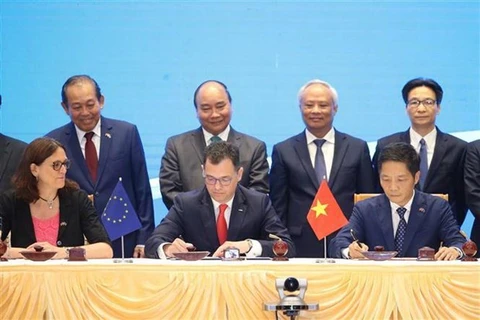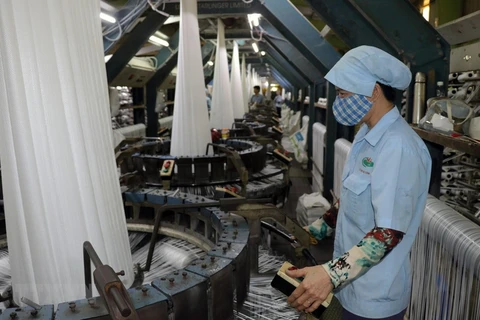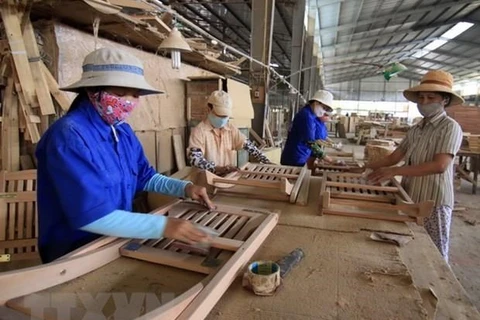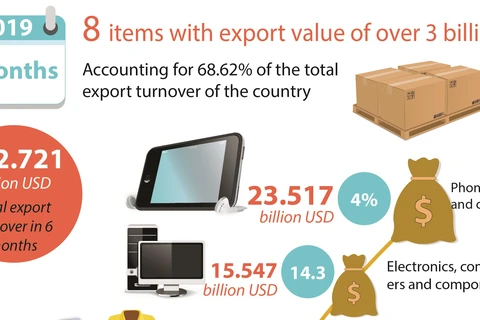Hanoi (VNA) - In the first six months of 2019, Vietnam’s import-export turnover exceeded 200 billion USD. However, poor market conditions have significantly affected the prices of many key exports.
According to the Ministry of Industry and Trade, exports through the first months of the year increased compared to the same period last year, but were not sustainable.

Prices of many agricultural products for export tended to decrease in the first months of 2019 (Source: VietnamPlus)
Prices of agricultural and aquatic products tumble
Statistics from the Ministry of Industry and Trade show that in the first half of 2019, the country’s export turnover was estimated at 122.4 billion USD, up 7.1 percent over the same period in 2018.
In the period, the country's export turnover reached only 46.55 percent of the plan set for the year. Ofthis, exports from the fully domestic-owned area were estimated at 36.67 billion USD, up 10.4 percent year-on-year, while the foreign invested area (including crude oil) reached 85.75 billion USD, 5.7 percent higher than that of the same period last year.
Notably, export turnover of agro-aquaculture products decreased by 6.9percent compared to the same period of 2018, estimated at 12.4 billion USD. In this group, seafood earned 3.93 billion USD, down 0.8 percent year-on-year.
Coffee exports also decreased by 10.6 percent in volume and 21.1 percent in turnover. In addition, rice exports fell 2.9 percent in volume and 17.6 percent in turnover, while exports of cassava and cassava products fell 17.7 percent in volume and 13.9 percent in turnover.
The six-month export turnover of fuel and mineral products was estimated at 2.31 billion USD, down 0.5 percent year-on-year.
Processed industrial products continued to play a leading export role in the period, with a turnover of more than102.2 billion USD, up 9.1 percent year-on-year, and accounting for 83.5 percent of the total export turnover.
The main products of the processing industry group recorded increased turnover compared to the same period of 2018.
Telephones and spare parts increased 3.8 percent, reaching 23.5 billion USD; computers, electronic products and components rose 13.9 percent, reaching 15.5 billion USD; and textiles and garments increased by 9.9 percent, reaching 15.04 billion USD; and footwear increased by 14.2 percent, hitting 8.81 billion USD.
However, exports to countries that have signed free trade deals with Vietnam
recorded stable growth. Exports to Japan, the Republic of Korea and ASEAN reached 9.68 billion USD, 9.24 billion USD and more than 13 billion USD; up 9.1 percent, 6 percent and 6.7 percent, respectively.
Export increases but not sustainable
Import value in the reviewed period was estimated at 120.78 billion USD, up 8.8 percent compared to the same period in 2018.
Particularly, the 100 percent domestic-owned area was estimated to reach 51.66 billion USD, up by 12.5 percent year-on-year, while the foreign-invested area hit69.12 billion USD, 6.1 percent higher than the same period last year.
Computers, electronic products and components had the highest import turnover, reaching 23.87 billion USD, up 18.7 percent over the same period last year
Meanwhile, import turnover of machinery, equipment, tools and spare parts also increased sharply by 12.5 percent, worth17.54 billion USD. In addition, imports of fabrics reached 6.55 billion USD, up 4.4 percent year-on-year;plastic products increased 7.4 percent; and raw materials for textile, garment, leather and footwear was up 5.1 percent.
With the above results, Vietnam enjoyed a trade surplus of about 1.64 billion USD in the first half of this year.
However, the domestic sector saw a trade deficit of nearly 15 billion USD, while the trade surplus in the FDI sector was approximately 16.6 billion USD.
Representatives from the ministry said export turnover through the first six months of the year was up compared to the same period last year but not stable.
The most obvious manifestation is that the trade balance still tends to reverse and has not reached stable growth. Moreover, export growth is easily affected by external factors such as price fluctuations in the world market and increasing trade and technical barriers.
These factors made export turnover in the first six months lower than the growth scenario of 123.5 billion USD set for the year.
To achieve export growth of 8-10 percent, the Government requested the industry and trade sector to devise measures, aiming to realisethe export turnover goal of between 23 billion USD - 23.4 billion USDin the last six months of the year.
This is a difficult task amid the global economic and trade depression.
However, with efforts by the Government, ministries and the business community in expanding markets and fostering trade promotion, the country’s exports are expected to complete the target, said representatives from the Ministry of Industry and Trade.-VNA


























